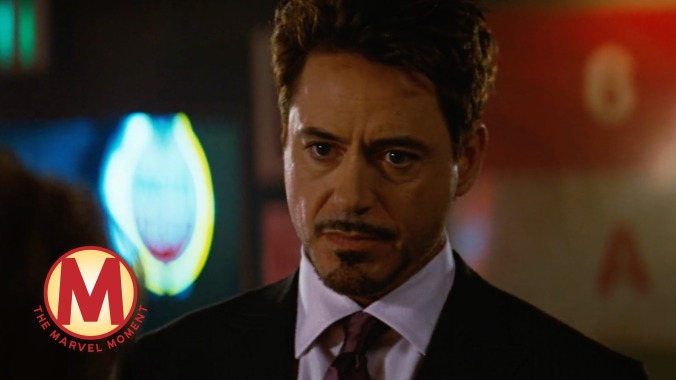A Tony Stark cameo opens the door on a much wider universe


Given how quickly (and thoroughly) the Marvel Cinematic Universe dispensed with Edward Norton’s take on tortured scientist-turned-big-green-rage-monster Bruce Banner, it probably behooves us to do the same as we make our way through the franchise’s past. So instead, let’s focus on the real contribution Louis Leterrier’s modest 2008 also-ran (and MCU sophomore effort) Incredible Hulk made to the overall structure of its parent universe: the codification of the vaunted post-credits scene as a way to say “Enough about those jerks; let’s build up hype for the next big thing coming down the line.”
Iron Man had, of course, already indulged in this particular tactic a month earlier. (Though it’s a little weird that Nick Fury refers to the “Avenger” initiative, singular, in his ominous little ending speech, right?) But it’s Tony Stark’s layover in Hulk town that sets the bladder-straining pattern for the next 19 movies to come, each ending with one—and sometimes even two—bits of ominous foreshadowing or character comedy, there to delight anybody willing to stick it out in their seats (or wait for the inevitable YouTube rip).
Hulk’s scene has all the hallmarks of post-credits success: a slow-burn introduction, a sudden appearance by a fancy guest star who hadn’t showed up in the movie until that point, and a whole bunch of pointedly vague dialogue about “teams” and “suits.” (It’s still too early for there to be any heavy-handed conversations about brightly colored, implausibly omnipotent rocks, but hey, give ’em a minute: We’re only two movies in at this point.) On paper, it’s almost painfully simple: The film’s secondary antagonist, General Ross (William Hurt), is drinking his sorrows away in a bar. Tony Stark shows up. They banter. That’s really it.
What’s fascinating about the Hulk scene, then, is how thoroughly it accomplishes its goals, despite the fact that nothing that happens in it actually matters, or even makes a lick of sense. Despite Stark’s offer of implied recruitment, Thunderbolt Ross wouldn’t show up in the MCU again until Captain America: Civil War, eight years and 11 films later—by which point Hurt was essentially playing an entirely different character, far removed from the cartoonish Javert chasing Norton’s Hulk around. Even Tony’s status as an ostensible Avenger(s?) recruiter is mostly baffling, in light of his distance from the project at the start of Iron Man 2.
But none of that matters because, well, Iron Man was in the Hulk movie, damn it! Way back in 2008, a shared cinematic universe was still an ambitious, weird, and above-all-else risky prospect for a major studio to embark upon. By talking Robert Downey Jr.—effortlessly cool, as ever—into spending an afternoon filming in some fake bar set opposite William Hurt, Marvel Studios suddenly made the long-imagined dream of creating a big cinematic playground for all its character to run around in a reality. And the MCU post-credits sequences would continue to serve this same function for a decade-plus to come, acting as the connective tissue for an entire expanded universe, and never letting audiences forget that they were only viewing a zoomed-in part of a bigger, much wider whole. In 2019, these now-mandatory little mini-films are de rigueur, even a little hokey. But they also put the “universe” in the Marvel Cinematic Universe, something that started all the way back here with Hulk. Its star might have been discarded, its plot beats ignored. But this one small part of the MCU’s mostly forgotten second son lives on.